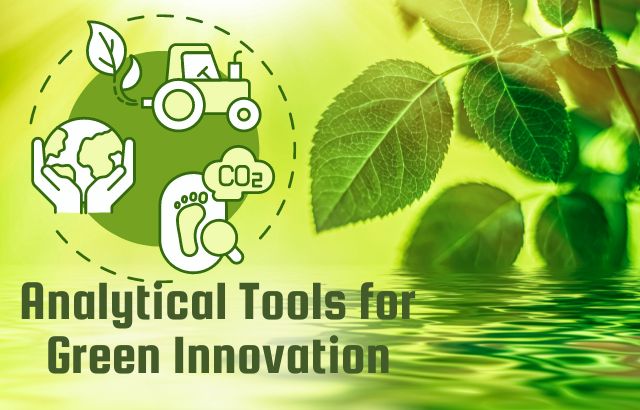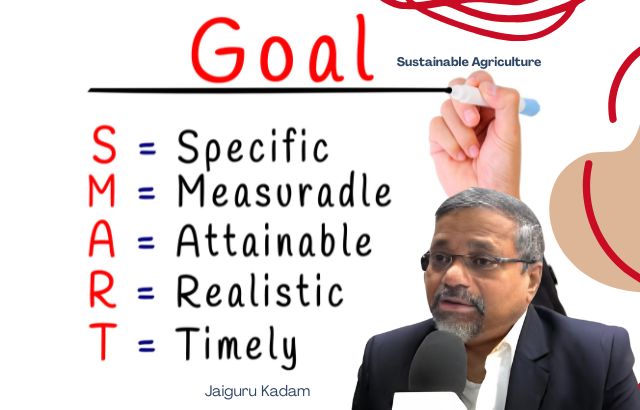Green innovation is no longer just a buzzword—it’s a necessity in the face of climate change, environmental degradation, and unsustainable development. But what does it mean to innovate greenly, and why is “letting go” such an essential component of that process?
As a Subject Matter Specialist in green innovation, with vast international experience, Jaiguru Kadam explains that letting go refers to releasing old, outdated, or harmful practices that no longer serve our planet, and instead embracing new technologies and business models that prioritize sustainability.
Let’s break down why this concept of “letting go” is critical in the world of green innovation, with real-world examples from industries like food, personal care, and agriculture, plus some insightful calculations to make the concept clearer.
Why Letting Go Is Crucial for Green Innovation

Rethinking Traditional Practices:
Green innovation challenges industries to leave behind unsustainable practices. These might include reliance on fossil fuels, resource-heavy manufacturing methods, or outdated waste management systems.
Example:
The automotive industry is a prime example of letting go of traditional practices. As Jaiguru Kadam points out, the shift from internal combustion engine (ICE) vehicles to electric vehicles (EVs) is a perfect case of this paradigm shift. Historically, the automotive sector was built around gasoline-powered cars, which not only contribute significantly to air pollution but also depend on a finite resource—oil.With the introduction of EVs, such as Tesla’s Model 3 or the Nissan Leaf, the focus is on energy-efficient, zero-emission vehicles powered by renewable sources like wind or solar. Letting go of the ICE vehicle manufacturing process and embracing electric motors, battery technology, and energy storage innovations is a major breakthrough in green innovation.
Breaking Free from Carbon-Intensive Energy:
Energy production has long been a major contributor to environmental pollution. The transition from fossil fuels to renewable energy sources is a textbook example of letting go in action.
Example:
Take Denmark, which has set ambitious goals for renewable energy adoption. In 2020, nearly 50% of Denmark’s electricity came from wind power alone. This success has been driven by the country’s commitment to letting go of coal and oil power plants, making way for cleaner, more sustainable wind and solar energy. As Jaiguru Kadam explains, such large-scale transitions not only help reduce carbon emissions but also spur further green innovation in energy storage and grid management.
Innovating Circular Economy Practices:
One of the most important shifts in green innovation is the move from a linear economy (take, make, dispose) to a circular economy. This involves rethinking how products are made, used, and reused.
Example:
Companies like Patagonia and Ikea have led the way in circular product design. Patagonia’s Worn Wear program encourages customers to buy used gear or trade in their old products for store credit, ensuring that goods stay in circulation longer and out of landfills. Similarly, Ikea is moving toward sustainable product design by creating furniture that can be recycled or repurposed instead of ending up as waste.
Real-World Examples of Green Innovation in Different Industries

1. Green Solvents in the Chemical Industry:
Traditionally, industrial processes have relied on solvents made from petroleum products, which can be harmful to both human health and the environment. Green solvents, on the other hand, are derived from renewable resources and are less toxic, biodegradable, and safer for workers.
Example:
In the pharmaceutical industry, the shift to green solvents is gaining traction. A company like Cargill has been using bio-based solvents made from plant materials to replace toxic, petroleum-derived solvents in the production of medicines and vaccines. This innovation has not only reduced the environmental footprint of pharmaceutical production but also minimized the risk of pollution from hazardous chemicals.
Why it matters: Green solvents help minimize hazardous waste and pollution, reducing the environmental and health risks posed by traditional solvent-based processes.
2. Green Surfactants in the Personal Care and Cleaning Industry:
Surfactants are a key ingredient in many cleaning and personal care products like soaps, shampoos, detergents, and cosmetics. Traditional surfactants, often derived from petrochemicals, can be toxic to aquatic life and take longer to degrade.
Example:
In the personal care industry, BASF and Clariant have developed plant-based, biodegradable surfactants as alternatives to the conventional, petrochemical-based surfactants. BASF’s Plantacare® surfactants are derived from renewable sources such as coconut oil and palm kernel oil, providing the same cleaning power without the environmental impact.
Why it matters: Green surfactants offer a more sustainable solution by reducing the environmental footprint of products and promoting a safer, more eco-friendly alternative for consumers.
3. Green Innovation in the Food Industry:
The food industry has long been criticized for using unsustainable practices, including excessive use of pesticides, artificial preservatives, and food packaging waste. Green innovation in this sector focuses on more sustainable farming practices, eco-friendly packaging, and safer, organic alternatives to traditional pesticides.
Example:
Beyond Meat and Impossible Foods are two companies leading the way with plant-based meat alternatives. These products have a significantly lower carbon footprint compared to traditional animal agriculture, requiring fewer resources like water and land. Additionally, these companies have been working on reducing the environmental impacts of their production processes by using green solvents in flavor extraction, thus reducing the reliance on harsh chemicals in food processing.
Why it matters: Green innovation in the food sector helps reduce the environmental impact of food production, from emissions to waste, and makes healthier, more sustainable food options accessible to consumers.
4. Green Pesticides in Agriculture:
Traditional chemical pesticides are often toxic to non-target species, including beneficial insects, animals, and even humans. Green innovation in agriculture focuses on more sustainable pest control methods that minimize harm to ecosystems.
Example:
Companies like EcoSMART Technologies have developed green pesticides using natural ingredients like plant oils and minerals. These eco-friendly alternatives are just as effective at controlling pests but without the harmful side effects of conventional pesticides.
Why it matters: Green pesticides reduce the risk of environmental contamination and promote biodiversity by protecting non-target species, thus fostering healthier ecosystems.
5. Green Innovations in Skin and Hair Care:
The personal care industry, including skin and hair care, is moving toward greener alternatives by eliminating harmful chemicals in favor of plant-based ingredients, biodegradable packaging, and sustainable manufacturing processes.
Example:
The brand Lush Cosmetics is a great example of a company using green innovation to rethink personal care. Lush has replaced synthetic chemicals in their skincare products with natural alternatives, using ingredients like coconut oil and olive oil. They have also reduced their packaging by promoting “naked” (packaging-free) products, further reducing waste. Another innovation has been the use of green surfactants in their shampoos and body washes, making their products both eco-friendly and effective.
Why it matters: These green innovations reduce the environmental footprint of personal care products, from production to disposal, and provide consumers with safe, natural alternatives to chemical-laden products.
The Role of Jaiguru Kadam in Green Innovation

As an expert in green innovation, Jaiguru Kadam has worked globally with businesses, governments, and NGOs to drive sustainable change. His experience spans sectors from energy to manufacturing, helping organizations let go of harmful practices and embrace more sustainable alternatives.
Jaiguru Kadam has been instrumental in shaping several large-scale renewable energy projects. For instance, he helped launch a solar microgrid project in rural India, enabling off-grid communities to access clean energy without relying on coal-powered plants. This project is a classic example of how letting go of centralized, fossil-fuel-dependent energy infrastructure opens the door to decentralized, renewable energy solutions.
Additionally, Jaiguru Kadam has played a key role in developing eco-friendly supply chains for global companies, encouraging the adoption of sustainable materials, waste reduction practices, and closed-loop production systems.
Frequently Asked Questions (FAQs)

1. What does “letting go” mean in green innovation?
Letting go in green innovation refers to moving away from outdated, unsustainable practices, technologies, or mindsets. It’s about embracing new, innovative solutions that reduce environmental impact and promote sustainability.
2. How can businesses benefit from letting go of traditional practices?
By adopting green innovations, businesses can not only improve their environmental impact but also open up new markets, reduce costs, and comply with regulatory requirements. For example, companies that reduce waste or energy consumption often see lower operational costs and increased efficiency.
3. What are some examples of successful green innovation?
Some notable examples include:
- Green solvents in pharmaceuticals and cleaning products.
- Plant-based alternatives like Beyond Meat and Impossible Foods.
- Green pesticides that are safer for ecosystems and people.
- Green surfactants used in personal care products.
4. How do green innovations help fight climate change?
Green innovations reduce carbon emissions, energy consumption, and waste, all of which directly contribute to mitigating climate change. Shifting to renewable energy, for instance, lowers the amount of greenhouse gases released into the atmosphere.
5. How does green innovation contribute to economic growth?
Green innovation can drive job
creation in sustainable industries, reduce costs through energy efficiency, and create new market opportunities for environmentally friendly products and services.
Conclusion

Letting go of outdated practices, whether it’s in energy production, manufacturing, or consumer behavior, is key to driving green innovation. By embracing new, sustainable technologies and mindsets, we can build a more resilient, environmentally friendly future. Jaiguru Kadam, with his vast international experience, continues to guide organizations and communities toward solutions that not only benefit the planet but also create new opportunities for businesses and individuals alike.
The process of letting go isn’t easy, but it’s essential for creating the innovative, sustainable world we need. As the green revolution picks up steam, the role of pioneers like Jaiguru Kadam will be critical in leading us forward into a more sustainable and equitable future.
Have any other questions about green innovation? Let me know, and I’ll be happy to share more insights!










